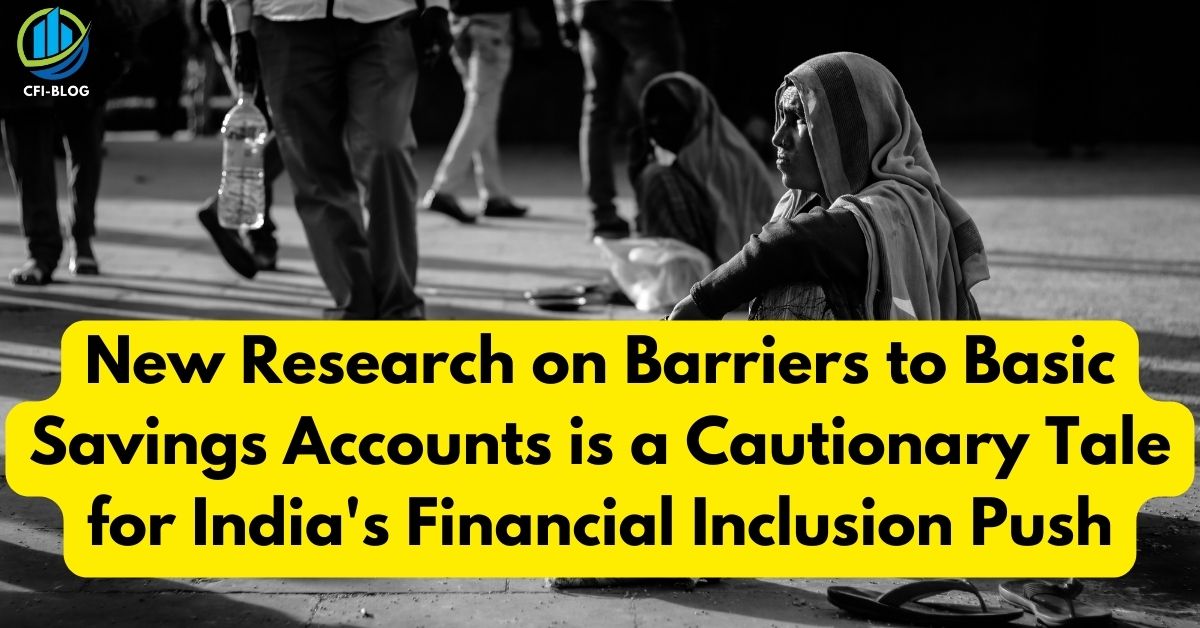In today’s world, financial inclusion is very much needed; with technological advancements, it is hard to imagine that around 65% of the world’s population is unbanked. If an individual is not a part of any financial institution, it becomes very hard for that person to grow and prosper. A bank account can help you store money, can help you save money, and whatnot.
The Indian Government seeing the need for Financial inclusion, launched the program Jan Dhan Yojana, this program was aimed at making the unbanked population of India included in the financial process.
A regular savings account could not be an option for many low-income individuals, so the RBI launched a Basic savings deposit account in which you didn’t have to keep a low minimum balance to run it. Well, in this write-up, we have mentioned what a BSBDA account is, and the barriers faced by the Indian government for Financial inclusion. So, let’s get started.
What is a Savings Account?

A savings account is a safe place where you keep your hard-earned money for any future needs or a particular goal. It is like a deposit account that is provided by the bank to keep your savings. The process works as follows: you deposit your money into a savings account, and that money is then lent by the bank to someone who is seeking a loan. The bank earns money from the interest on the loan, and you will be given interest on the amount that you have kept in that savings account.
Now coming to the interest rates that a savings account provides. Usually, all the banks provide an interest rate ranging from 6% to 7%. This interest rate is given on condition that the account must have a minimum balance of 75K to 1lac. The interest rates are variable; they can change from 4% to 6% in 24 hours. The interest rate is calculated monthly, and it is paid by the bank quarterly.
Minimum balance requirement changes based on the type of bank account. There are some account types that do not require a minimum balance; these accounts are called basic savings deposit accounts (BSBDA). Accounts that have a requirement of a minimum balance have a policy of having a minimum balance in that account. Otherwise, the account holder may be penalized. The minimum balance requirement changes from bank to bank but follows a general set of client protection laws and regulations in microfinance.
As mentioned, there are zero balance accounts. Also, these accounts do not charge any type of penalty if the account does not have a minimum balance. These types of accounts are usually opened by students, low-income individuals, etc. The benefits of having a savings account are limitless, as savings are key to merchant payments in developing countries.
According to reports issued by banks, around 90% of accounts are savings accounts. When you apply for a savings account, the account holder gets a checkbook, by which you can write a check and cash it. You will be provided with a debit card with which you can withdraw cash from an ATM. The debit card can be used for purchasing, dining, etc.
If the bank provides an online banking facility, then you can access your account via phone, PC, or tablet. Transferring mechanisms like NEFT/RTGS/IMPS can also be done with a savings account. These methods are faster and very accessible; you don’t need to go to any physical location. A savings account can be opened by a resident of India or an NRI (Non-Resident of India), any minor who is under a guardian, or by any educational institute, Society, etc.
A savings account cannot be opened by a Company/business firm or any government department. There are no charges charged by the bank when you are about to open any savings account. However, if your account has a minimum balance policy, there can be penalties charged if your account does not have that much balance.
What is a Basic Savings Deposit Account?
A basic savings account was made for people for whom a savings account is out of their reach. As a savings account has a policy of minimum balance, it becomes difficult for low-income individuals to always maintain a minimum balance in their respective accounts. To give an alternative to economically weaker people, the Reserve Bank of India has introduced the option of a Basic Savings Bank Deposit Account (BSBDA).
In this type of account, a person doesn’t have to have any kind of minimum balance to run the account. In the case of the BSBDA account, the account holder gets a debit card that can be used. An Accountholder gets a certain limit on the number of withdrawals and deposits in their account. If they cross that limit the bank may charge a fee for further withdrawals and deposits. They even get a passbook that they can update to see the account balance and transactions made.
Other features that both a regular savings account and a BSBDA account also have been providing a checkbook, demand drafts, electronic statements, etc. Cashing a check and a DD will cost similar to a normal savings account. Read more about the different types of Savings Accounts available, and apply for a Savings Account here.
Conditions on a BSBDA Account:
There are certain conditions that a BSBDA account holder should follow; as it is a no-frills zero balance account, the conditions are maintained that would be appropriate for lower economic background people. The conditions are:
- The maximum amount that a BSBDA account can have is Rs.50,000. This is the maximum amount an account holder can deposit in his or her account.
- Total credit made to this account has a limit of Rs.1,00,000.
- The maximum withdrawal amount in this type of account is Rs.10,000 monthly.
- An account holder can make at most 4 withdrawals each month.
- If someone does not follow these conditions or is not eligible for these conditions, the account can get converted to a regular savings account.
However, you mustn’t forget that an account holder having a regular savings account in a bank cannot have a basic savings account in the same bank. If you want a basic savings account, you can change your current savings account by following the above conditions.
How to Open a BSBDA Account?
To open a BSBDA account, you need to make sure that you do not have a savings account in that bank. You need to have complete KYC, meaning acceptable photo ID proof and address proof, according to the bank guidelines. If you have a regular savings account in a bank, you cannot have a BSBDA account in the same bank. You have to fill out an undertaking form stating that you want to convert your regular savings account into a BSBDA account.
Further, your regular savings account will get closed, and then you can then open a BSBDA account. For people who face difficulties while maintaining a low account balance, a BASDA account can greatly help. In a BSBDA account, you won’t have to worry about maintaining even a low balance and penalties if you fail.
Benefits of a Basic Savings Deposit Account
There are multiple benefits of a Basic Savings Deposit Account, this account particularly targets low-income individuals. Some of the benefits have been mentioned below:
Attractive Interest Rates
BSBDA accounts also have interest rates that are similar to regular savings accounts. So, there is no major difference between these types of savings accounts. However, the interest rates can vary from bank to bank. One must compare all the options and then make a choice. Earning interest over your saved money is one of the reasons why low-income individuals prefer BSBDA accounts.
Cashback Offers and Rewards
There are various rewards when you open a zero savings account. Just like a regular savings account, you can apply for a debit card in a zero savings account. When you purchase any item with it, you may be eligible for rewards. Some banks, like the Indusland bank, offer rewards such as discounts on any amazon purchases, cashback on Swiggy orders, etc.
E-Mandate Set Up
Some of the banks give a facility for net banking in that case, you can automate your bill payment system. By applying this feature, you can save money by not paying penalties or any kind of fees.
Easy Account Opening Process
The process of opening a zero savings account is very simple. Almost every bank now offers a zero savings account. However, make sure to carry the documents required for KYC.
What is Financial Inclusion?
The word “financial inclusion” would mean to include everyone in a society in day-to-day financial processes. This can be done by making the process more accessible and convenient. If the barriers that are stopping the individuals from getting included in the financial process are removed. The lives of these individuals will only improve. The process of removing the barrier is also called inclusive finance.
A report published by the World Bank states how financial inclusion benefits individuals. Financial inclusion helps individuals who were not a part of any bank or any other financial institution become a member of some financial institution. If you are a member of any financial institution, you will be using their services such as a savings account, debit card, insurance, etc. you can use these features to lend money and expand your business; the money you will earn from your business can be invested in healthcare, education or any other sectors. All these things will eventually result in the development of society and improve the quality of life.
Financial inclusion has been a problem for a long time. However, now, some organizations are helping reimagine the study of financial inclusion. With time, the financial industry is flourishing and coming up with new ways that are efficient and inexpensive too. The introduction of Fintech companies has erupted in the financial system. With the booming of fintech companies, it is sure that the future of payments is digital. Due to the services provided by the fintech companies, it has become a lot easier for consumers who used to face difficulties in operating an account.
Nowadays, Payments are becoming cashless, which makes it even more convenient. You can send money from one account to another account via mobile phone, tablet, or PC.
With the introduction of P2P lending, many people who do not have a Credit History can access financial lending with the help of fintech apps. However, with these kinds of technological advances, a certain percentage of the population has benefitted. Although, many of the population have still not been affected.
If we just talk about the United States, almost 4.5 percent of U.S. households (approximately 5.9 million) are still unbanked. This survey was conducted in the year 2021. Although you need to keep in mind the security hazards with the expansion of the fintech industry, financial inclusion, and immigration in Europe disrupting identity norms is pretty casual.
The World Bank has taken the initiative to expand financial inclusivity; that’s why they have started the program Universal Financial Access 2020. This program is co-sponsored by the International Finance Corporation as well. The program aims to give financial access to 1 billion adults in the whole world. This population will have an account that they will use to transact money, send money, etc. the program aims to make this happen within the year 2020.
Through this program, a large population who does not have even basic access to a bank account will be given access to financial services. Currently, according to the World Bank, the estimated population of unbanked adults is around 1.4 billion.
Benefits of Financial Inclusion
Today India is the fifth largest economy in the whole world. It is more than some of the developed countries. Despite this achievement, a large population of the country remains unbanked. Financial inclusion is the right course of action to solve this issue. However, financial inclusion is a new term in India. Financial inclusion in India would mean affordable banking facilities and a maximum reach of these facilities to all underprivileged people.
According to Global Experts, Financial Inclusion should include everyone and should not focus on one area. If the service is provided in rural areas, those services should be provided in backward cities present in the urban area as well. With overall development, only the unbanked population of India will have access to Financial Services.
With the emphasis on financial Inclusiveness, a lot more people will save money in savings accounts, transact money from one account to another, take out a loan, etc. You can use these features to expand your business, build a house, and so on. Thereby slowly removing the idea that discrimination and credit underwriting are inseparable. These things will eventually help society by contributing to the overall economy of the nation. It will vastly improve the overall quality of life of the entire population.
Why Financial Inclusion in India is Important?
With Financial inclusivity, the unbanked population of the country will have access to financial services. To achieve this a combined effort of the government and the RBI should take place. This will positively impact the economically weaker section of our Country.
According to financial experts, financial inclusion is going to be the stepping stone to the next economic revolution. The Indian government is making the right decisions toward achieving financial inclusivity. With programs like “Pradhan Mantri Jan Dhan Yojna,” the government is targeting the 65% unbanked population of India, a growing-country demographic that is drowning in overindebtedness, according to Africa board fellows deliberate thus on the findings.
Programs to Expand Financial Inclusion (Jan Dhan Yojana)
There are several initiatives launched by the Indian government to increase financial inclusivity. One of the major programs was the Pradhan Mantri Jan Dhan Yojana (PMJDY). It is one of the largest investment programs in the world. This program was initiated by the Prime Minister Of India on 15 August 2014. He started this Program to uplift the poor by giving them access to basic financial needs. The program started on August 28.
With the help of this program, low-income individuals will get access to financial services that they didn’t have earlier. Services like a debit card, savings account, Loans, and Insurance.
There is a record registered in the Guinness World Record for Most Bank accounts opened in one week. The program came under the Ministry of Finance.
However, the initial target was around 7.5 crore bank accounts, but till Jan 26, 2015, the number of accounts opened was 12.54 crore. The program exceeded its initial target. A survey was conducted after 31 Jan 2015; the survey stated that 21.02 million households in India had accounts that had a minimum balance of Rs 10,000 on average. Today, the program has covered almost the entire unbanked population. In this program, 60% of the accounts were opened in the rural part and 40% in the urban area. The overall female share of the accounts is around 51%.
Drawbacks Faced by Jan Dhan Yojna
After the arrival of the Jan Dhan Yojna Program, many barriers were seen that the program had to face. The barriers included:
Poor Strategy of PSBs
PSBs meaning public sector banks there were major flaws in the operation of this program by the PSBs. They have a lot of bad assets and risky loans that create problems in initiating zero-balance accounts. There were some differences between the central Government and the RBI that affected the execution of this program.
Limitations on Connectivity
In the case of some rural areas, many districts come under the NREGA program. In that program, the village people keep their money in the panchayat department under the “no-co-cooperation” they keep their salaries with block panchayat officials which is their lowest level of governance. Jan Dhan Yojana didn’t address this issue.
Financial Information
After this program, there was no effective financial Information about the success of the program. A financial tool kit launched by the RBI in 2013 states that a government should provide cost-effective lessons to consumers rather than following a consumer-based approach.
Frequently Asked Questions (FAQs)
Q1. What are the major barriers to financial inclusion in India?
Programs launched by the government of India for Financial Inclusion did face many barriers. Barriers such as lack of capital, Poor management of the banks, lack of formal credit, etc. These were some of the barriers faced to Financial inclusion in India.
Q2. What are some obstacles faced by the Indian banking sector for financial inclusion?
There were several problems that the banks had to face while implementing Financial Inclusion, lack of proper management, lack of documents, and low skill-set in bank employees. Many people who wanted to open a zero-balance account came from a backward society; they did not carry the necessary documents that were required for opening an account.
Q3. How safe are savings accounts in India?
Every bank in India is Insured by the DICGC; it does not matter if it is private or public. The insurance is up to 5 lakhs for both the principal and the interest earned. So, savings accounts in India are pretty safe.
Q4. What is India’s financial inclusion?
Financial Inclusion has been discussed by the Reserve Bank of India since 2005. Financial inclusion aims towards providing the following: A basic savings deposit account that can be used for payments by debit card, credit card, etc. There is no minimum balance policy related to this account.
Conclusion
Overall, if we look, there are many benefits to a savings account, but a regular savings account does not meet the needs of a low-income individual. In the case of a regular savings account, you have to keep a minimum balance in your account to keep it active. The solution to this problem is a Basic savings deposit account (BSDBA) in this type of account, you won’t have to keep a minimum balance. You can open a BSBDA with zero deposit.
To spread this account and to include the majority of the unbanked population in the financial process. The major program was the Jan Dhan Yojana launched by PM Narendra Modi; the Program targeted the Unbanked Population of India, which is around 10 crore people. However, there were many barriers to this program, as the banks had not properly strategies the process to cover the program.
Author Profile

- Jonas Taylor is a financial expert and experienced writer with a focus on finance news, accounting software, and related topics. He has a talent for explaining complex financial concepts in an accessible way and has published high-quality content in various publications. He is dedicated to delivering valuable information to readers, staying up-to-date with financial news and trends, and sharing his expertise with others.
Latest entries
 BlogOctober 30, 2023Exposing the Money Myth: Financing Real Estate Deals
BlogOctober 30, 2023Exposing the Money Myth: Financing Real Estate Deals BlogOctober 30, 2023Real Estate Success: Motivation
BlogOctober 30, 2023Real Estate Success: Motivation BlogOctober 28, 2023The Santa Claus Rally
BlogOctober 28, 2023The Santa Claus Rally BlogOctober 28, 2023Build Your Team – the Importance of Networking for Traders
BlogOctober 28, 2023Build Your Team – the Importance of Networking for Traders

